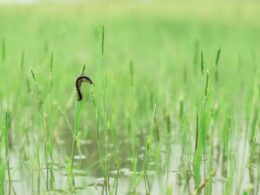About Bottlebrush Grass
Bottlebrush grass is a perennial grass that is native to eastern North America. Due to its distinctive flowers, it’s often considered a wildflower. Bottlebrush grass is a hardy plant that can tolerate a wide range of soil and light conditions. It prefers full sun, but will also grow in partial shade. It is a fast-growing grass that can reach up to 2 feet in height.
Bottlebrush grass attracts butterflies and other pollinators. It blooms from June to August, with flowers in spikelets that range in color from pale green to purple. The flowers are followed by seeds that are dispersed by the wind. Because of its bristly foliage, bottlebrush grass is an excellent choice for landscaping and can be used as an ornamental grass or as a ground cover.
Elymus Hystrix and Other Common Names
Bottlebrush grass is also known by its scientific name Elymus hystrix or as eastern bottlebrush grass. It gets its name from its long, cylindrical inflorescence, which resembles a bottle brush. The “eastern” part refers to the distribution, which is in the North Eastern USA and Canada.
Hystrix Patula
Hystrix patula, also known as hairy sedge, is a similar looking plant that is also native to North America. It’s very often considered the same plant as bottlebrush grass. Both plants have prickly seed heads and long, slender leaves. However, there are some key differences between the two species. For instance, Hystrix patula is more tolerant of salt and drought than Elymus hystrix. Additionally, Hystrix patula produces larger seeds than bottlebrush grass. It does belong to the Elymus family, though.
How to Grow Bottlebrush Grass
Bottlebrush grass is a relatively easy plant to grow, and it can be used in a variety of ways in the garden. Here are some tips for growing bottlebrush grass:
- Soil: bottlebrush grass prefers well-drained soil with a neutral pH. If your soil is too alkaline or acidic, you can amend it with lime or sulfur, respectively.
- Watering: water bottlebrush grass regularly during the growing season. Allow the soil to dry out between watering, but do not let the plant stress from lack of water. In the winter, reduce watering to once per month.
- Care: bottlebrush grass does not require much fertilizing. Once per year, in the springtime, is sufficient. You can either use a general purpose fertilizer or one specifically formulated for ornamental grasses. Also, be sure to trim back the plant in late winter or early spring to promote new growth.
Ornamental Properties of Bottlebrush Grass
Bottlebrush grass is a versatile and attractive ornamental grass that can add interest to any garden. Bottle-brush grass can be used as an accent plant or mass planted to create a naturalistic look. The grass can also be used as a ground cover in areas where other plants have difficulty growing.
Eastern Bottlebrush Grass Distribution and Use
Bottlebrush grass is a native bunchgrass that is found in parts of the eastern United States. Eastern bottlebrush grass is found in a variety of habitats, including woods, prairies, and disturbed areas. It is a hardy plant that is tolerant of both drought and flooding. The grass has a deep root system that helps to stabilize the soil and prevent erosion. Eastern bottlebrush grass is an important food source for many animals, including deer, rabbits, and quail. The seeds of the plant are also eaten by songbirds, game birds, and small mammals.
Image Source: SB Johnny via Wikipedia, CC BY-SA 3.0



















